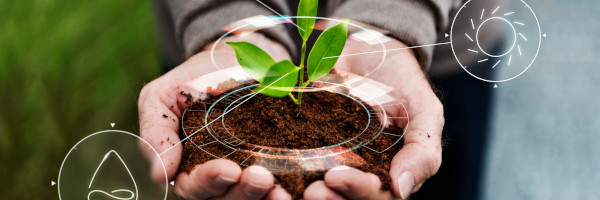Regenerative Agriculture
| Agriculture | ||||||||||||||||
|---|---|---|---|---|---|---|---|---|---|---|---|---|---|---|---|---|

| ||||||||||||||||
| Sectors | Agriculture | |||||||||||||||
| Contact | Ed Lisle | |||||||||||||||
| Topics | ||||||||||||||||
Activities
Press
| ||||||||||||||||
- Authors
REGENERATIVE AGRICULTURE (RegenAG) involves shifting from a carbon intensive food system to carbon-negative agriculture that restores rather than degrades ecosystems. While there is no globally accepted definition, this term is widely accepted to refer to integrated systems of farming, ranching, and pastoral practices that contribute to stabilizing the planet’s climate and carbon cycles by rehabilitating and safeguarding biodiversity and living systems.
A shift to Regenerative Agriculture signals a radical transformation of how, where and when we grow food, a great expansion of the varieties of seeds grown and a new microclimate-based approach focusing on smallholder farms, intercropping, agroforestry and micro-farming industry strategies. For example, the use of cover crops, crop rotation, and no till practices, reducing use or elimination of synthetic inputs, and employing integrated crop and livestock systems and managed grazing have long since been recognized as sustainable farming practices.
At the same time, new approaches are under development and ancient practices reinvented, some of which are up for debate as to whether or not they fall under the Regenerative Agriculture umbrella. For instance, while there is some debate about inclusion of soilless agriculture under the Regenerative Agriculture umbrella, there is growing consensus that organic soilless methods such as aquaponics (involving cultivation of fish that fertilize plants in interconnected, contained systems) represent promising, sustainable approaches to growing more with less water and energy and little to no pollution.
United Nations Sustainable Development Goals
The United Nations Sustainable Development Goal 2 is focused on creating a world free of hunger by 2030 by improving food security, nutrition and promoting sustainable agriculture. Of the 8 billion people living today, only three-quarters of us are receiving adequate nutrition. One billion people experience chronic hunger and as our population grows, more and more people are expected to experience food insecurity. It is starkly apparent that current industrial farming practices that squander and degrade the very resources they depend on cannot continue unchanged. Industrial agricultural practices are producing an estimated 21–37% of annual emissions of the three largest individual contributors to global warming gasses, carbon dioxide, methane, and nitrous oxide, and using 70% of the fresh water available on our planet (United Nations Food and Agriculture Organization, 2022). Clearly a large conservation and restoration effort is essential if we are to provide nutrition for an anticipated population of 10 billion by 2050, which is precisely what the Regenerative Agriculture movement seeks to enable.
Obviously no single solution is capable of fulfilling this lofty goal. A decade ago in 2012, the United Nations Conference on Sustainable Development (UNCSD), known as Rio+20, produced an outcome document that called for achieving a land-degradation-neutral world in the context of sustainable development. Given the current extent of land degradation globally, the potential benefits from land restoration for food security and for mitigating climate change are enormous. While it is true that scientific understanding of the drivers of desertification, land degradation and drought is still evolving, advocates of Regenerative Agriculture point out that these crises actually create new opportunities for increasing food security, carbon storage and climate resiliency.
Regenerative Agriculture approaches are already being implemented to varying degrees across our agricultural system, while others are newly emerging. Globally, movement is underway to return to native crops specifically adapted to variations in the local climate and to greatly increase the natural fertility and carbon sequestration potential of degraded soils. Nations such as Niger, with some of the most degraded soils on the planet, are demonstrating how restoration can be accomplished – restoring an astonishing 5 million hectares to productivity in the Sahel. Private/public partnerships such as the agroforestry project in inner Mongolia’s Kubuqi Desert, have restored approximately one-third of 18,600 sq km of sand dunes and in Mali, restoration has created forest plots with higher biomass than even native forests.
Key Trends Pushing Forward Regenerative Ag Practice Adoption
- Data and the Digital Ag Revolution
- Biologicals
- Carbon / Climate - Smart Commodities
Emerging Digital AG Revolution Solutions
A body of scientific literature is now emerging that presents numerous strategies to decouple food production from land area, enabling increased food productivity and nutrition on the current agricultural footprint. A few examples of solutions related to data and the digital ag revolution and smart communities include:
- Integrating AI enabled predictive analytics within indoor growing environments to precisely control growing variables in response to biotic and chemical signals at different stages of the growth cycle to reduce resource consumption and waste while maximizing rapid plant growth.
- Deploying controlled growing environments near to where produce is sold and consumed to drastically reduce travel time, resource consumption, pollution, and shipping costs to deliver fresher, nutrient-dense food that tastes better.
- Utilizing AI solutions for optimized outdoor crop placement
- IoT solutions such as robots, drones, remote sensors, and computer imaging combined with continuously progressing machine learning and analytical tools for monitoring crops, surveying, and mapping the fields, and providing data to farmers for rational farm management plans to save both time and money.
- Employing block-chain tracking to improve traceability of food to appeal to location-conscious buyers (sometimes called locavores), who are having an important impact on food sourcing, including the popularity of farmers markets.
OpenCommons Embraces The Formation Of A RegenAG Community: Call For Action
The purpose of this RegenAg/AgTech partnership with OpenCommons is to cultivate a collaborative community to advance promising smart technologies for urban and rural regenerative agriculture solutions.




